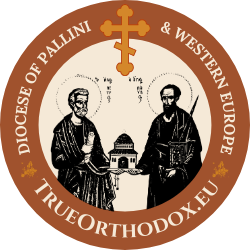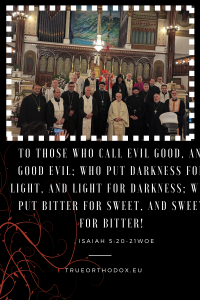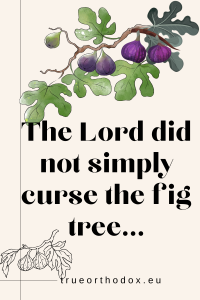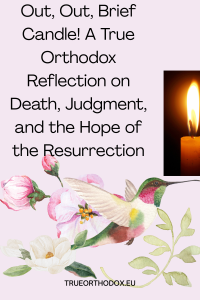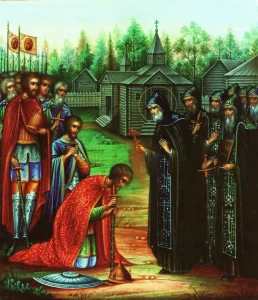THE STRUGGLE ON VALAAM
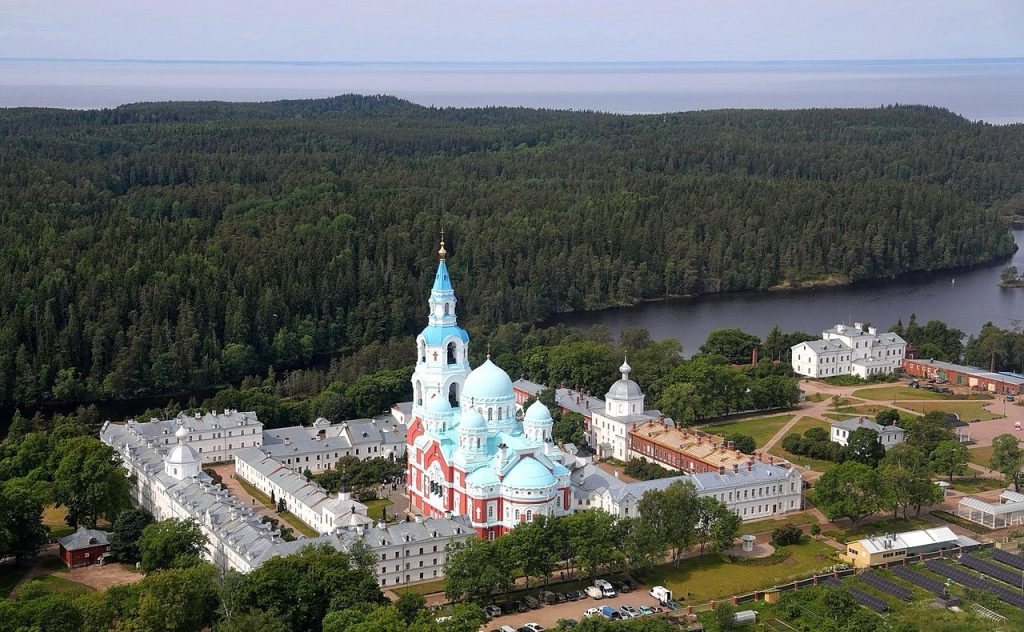
By Vladimir Moss
Only in one part of the Russian Church outside Russia was the new calendar ever implanted firmly – in Finland, whose Church had been taken away from the Russian Church by Patriarch Meletius of Constantinople. Already on July 19, 1923 he moved to force the great Russian monastery of Valaam, which was now outside Russia and within the bounds of the Finnish State, to accept the new calendar, writing mendaciously to Archbishop Seraphim (Lukyanov) that the new calendar had been accepted “with the agreement and by means of a decision of all the Orthodox Churches”.[1] Now, since the Finnish Church had accepted the western paschalion, it was likely that that, too, would be imposed on Valaam…
At a general assembly of the 600 brothers, writes Nun Angelina (Zhavoronkova), “Abbot Paulinus read out an epistle from Bishop Seraphim in which he said that both Patriarchs Meletius of Constantinople and Tikhon of Moscow blessed Valaam to change to the new style from October 4. Two days later Vladyka Seraphim arrived. He was met by the objections of the brotherhood and the request that they remain with the old style. This was refused to them, and less than two weeks later five of the protesting brothers were forcibly expelled from Valaam and deprived of the mantia.
“… On June 25, 1924 the new Bishop of Karelia visited Valaam. In November the Valaam monks presented him with a petition asking him to allow them to keep the celebration at any rate of Pascha according to the old style, but this, too, was refused them, and those who refused to obey the decrees of the Finnish Church were threatened with exile from Valaam.
“Fr. Michael [Popov] was the spiritual father of the brotherhood at this exceptionally difficult time for Valaam. He encouraged everyone to remain faithful to the traditions of the Holy Orthodox Church. He often served in distant sketes and deserts and encouraged other Fathers to follow him. His nearest disciple and follower, Elder Michael the Younger, at that time Fr. Timon, was one of the most zealous defenders of the Orthodox calendar right until 1939, when the Valaam brotherhood was forced to leave their beloved monastery.
“Secret resistance increased especially in 1925. Fr. Michael sent his spiritual children by night with prosphoras to Gethsemane skete for Fr. Timon and they unfailing fulfilled their obedience, covering six kilometres every night. From the first days of the resistance the Gethsemane skete had become the place where people gathered for services according to the Old Church Calendar.
“On the question of the calendar, the Valaam monks entered into correspondence with the Athonite zealots of Holy Orthodoxy, the so-called zealots, the elders of Karoulia, especially the learned monk Theodosius, who even wrote a whole composition about the importance of the calendar question. On Valaam Hieromonk Justinian, the main correspondent in this correspondence, was a disciple of Elder Michael. While Elder Theodosius was the last spiritual disciple by correspondence with Elder Theophanes the Recluse.
“In the evening on the eve of the monastery’s feast day of SS. Sergius and Herman of Valaam, September 10, 1925, Metropolitan Germanus of Thyateira, the representative of the Patriarch of Constantinople, arrived [from London]. Having gathered together the brethren, he declared that the new calendar was being introduced from now. On September 16 the brotherhood sent to Sortavala their own representatives in the persons of Fr. Michael, Fr. Joasaph the deputy, Fr. Jerome and the other older priests of the monastery to talk with Metropolitan Germanus. With tears they besought him to keep the old style in the monastery. In reply the metropolitan irritably shouted at them. On September 20 Metropolitan Germanus accompanied by Bishop Germanus arrived on the island to celebrate the all-night vigil. Half of the brotherhood did not come to the service. He called the brotherhood to peace and love.
“Immediately after this repressions began. The antimins were taken from all the skete churches. Fr. Timon was transferred from the Gethsemane skete to the main monastery. A little later Hieromonk Polycarp was exiled to Russia to almost certain death in the concentration camps for his published articles against the leadership of the monastery.”[2]
“On September 25, 1925,” writes Schema-Monk Nicholas of Valaam, “there was a division of people in Valaam as to the ‘old’ and ‘new’ style. Many of the brothers remained true to the old style. Legal proceedings began. The church administration arrived; there was a court with Abbot Paulinus in charge. They began to summon the brothers one by one, and many were expelled from the monastery. Then my turn also came. I went into the room, and there sat Abbot Paulinus with others from the church administration. Father Abbot said, ‘Here is a slave of God; ask him.’ One of them said that he would speak and that everything should be recorded. They asked, ‘Do you accept Fr. Paulinus as Abbot?’ ‘Will you go to church services according to the new calendar?’ I could not answer this question; it was as if my tongue had become paralysed. They hesitated and said, ‘Well, why aren’t you answering?’ I couldn’t say anything. Then they said: ‘Well, go on, slave of God, and think this over.’
“I began to pray to the Mother of God, my ‘Surety’, in my heart. ‘Tell me and indicate my life’s path: Which side should I go to, the new or old style? Should I go to the cathedral or somewhere else?’ And I, the sinful one, prayed to the Mother of God during my obedience in the kitchen. When I finished my evening obedience, I went to my cell and thought in the simplicity of my heart, ‘Why don’t you answer me, Mother of God?’ But the grace of God did not abandon me, a sinner. He wants salvation for all. Suddenly the cathedral appeared before me, the same as it is: the same height, length and width. I was amazed at this miraculous apparition – how could it enter my small cell? But my inner voice said to me: ‘Everything is possible with God. There is nothing impossible for Him.’ ‘Well,’ I thought, ‘one must go to church in the cathedral according to the new style.’ Then, as I was thinking thus, a blue curtain came down from above, in the middle of which was a golden cross. The cathedral became invisible to me, and the inner voice said to me: ‘Go to the old style and hold to it.’ And I heard a woman’s voice coming from above the corner: ‘If you want to be saved, hold fast to the traditions of the Holy Apostles and the Holy Fathers.’ And then the same thing was repeated a second time, and the third time the voice said: ‘If you want to be saved, keep fast to the tradition of the Holy Apostles and Holy Fathers, but not these “wise” men.’ After this miracle, everything disappeared and I remained alone in my cell. My heart began to rejoice that the Lord had indicated the path of salvation to me, according to the prayers of the Mother of God.” [3]
“On September 12, 1926,” continues Nun Angelina, “the former cathedral elders of Valaam, who had remained faithful to patristic Orthodoxy, were summoned to a new trial in Serdobol. The trial was pro forma, and 35 monks were condemned to exile, while the abbot was to deal with the rest, dispersing them among all the sketes.
“On October 9 the sentence was carried out. One of those exiled from Valaam, Hieromonk Nicander, the former spiritual father of the famed Lesna monastery, remembers:
“’We shall never forget that… sad day… Our own Abbot Paulinus and our own monastic brothers handed us over to the police… For the sake of temporary comfort, out of fear of men, they drowned out the voice of their conscience and transgressed the holy canons of the Church… The day of our exile that autumn was exceptionally quiet, Lake Ladoga was calm and the first powdery snow covered Valaam… By eight o’clock in the morning we had all gathered on the ferry… the Old Calendarist monks who remained, together with some unwilling new calendarists, came to say goodbye to us; not a few tears were shed on both sides. (Even the gendarme wept, remembered Fr. Philemon.)… How bitter it was for us to leave our native nest, but our souls were at peace, for we felt that we were suffering for the sake of righteousness and that God was with us.’
“On November 15 an Investigative Commission arrived at the monastery, and in the course of four days interrogated each of the brothers on their own, asking whether they recognised Bishop Germanus and whether they would serve with him. Fr. Michael was defrocked by a church court, removed from his obedience as Spiritual Father and exiled on December 15 to the distant St. Herman skete. (According to the words of Fr. Athanasius, who left memoirs of his elder, Fr. Michael was first exiled to Tikhvin island.) Thence he was transferred to the Skete of St. John the Forerunner in 1926, where he spent the following eight years [until his death on May 8, 1934], suffering from a weakness of the heart in the severe conditions of the strictest skete on Valaam. In that year 44 of the brothers were exiled and 48 left Valaam…”[4]
In 1939, when the Soviets captured Old Valaam, the spiritual life of the great monastery came to an end…[5]
[1] Monk Benjamin, op. cit., p. 106.
[2] Nun Angelina, “Starets Mikhail Starshij, ispovednik strazhduschego pravoslavia”, Russkij Palomnik, № 17, 1998, p. 64.
[3] Schema-Monk Nicholas, The Orthodox Word, №№. 160-161, September-December, 1991, pp. 268-270.
[4] Nun Angelina, op. cit., pp. 64-66. There was a nationalist, Russophobic element to the introduction of the new calendar in Finland. Bishop Germanus (Aav) forbade his priests to wear pectoral crosses of Russian make, and would even paint over Slavonic inscriptions on old icons. His successor, Paul (Gusev), was a Russian who pretended to be a Finn. He, according to one source, “showed an indefatigable concern for one thing alone: how to make services in his Church completely unlike those in the Russian Church (“Demons in cassocks”, orthodox-tradition@yahoogroups.com, December 22, 2003).
[5] In New Valaamo in Finland, according to the witness of a True Orthodox Christian who spent a year there before his conversion, there continued to be Russian monks who confessed the Old Calendar – an abbot named Symphorian and another monk over one hundred years old. They lived in separate quarters and refused all communion with the new calendarists and visiting Soviet hierarchs. Abbot Symphorian died in the 1980s; nothing is known about the other monk
